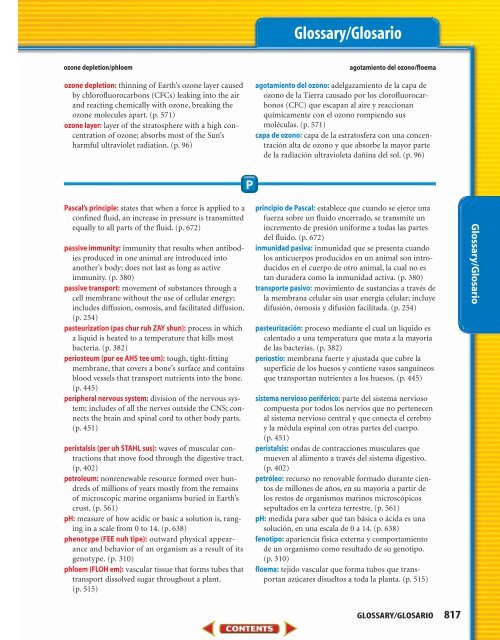Student Resources—746
Student Resources—746
Student Resources—746
You also want an ePaper? Increase the reach of your titles
YUMPU automatically turns print PDFs into web optimized ePapers that Google loves.
Glossary/Glosario<br />
ozone depletion/phloem agotamiento del ozono/floema<br />
ozone depletion: thinning of Earth’s ozone layer caused<br />
by chlorofluorocarbons (CFCs) leaking into the air<br />
and reacting chemically with ozone, breaking the<br />
ozone molecules apart. (p. 571)<br />
ozone layer: layer of the stratosphere with a high concentration<br />
of ozone; absorbs most of the Sun’s<br />
harmful ultraviolet radiation. (p. 96)<br />
Pascal’s principle: states that when a force is applied to a<br />
confined fluid, an increase in pressure is transmitted<br />
equally to all parts of the fluid. (p. 672)<br />
passive immunity: immunity that results when antibodies<br />
produced in one animal are introduced into<br />
another’s body; does not last as long as active<br />
immunity. (p. 380)<br />
passive transport: movement of substances through a<br />
cell membrane without the use of cellular energy;<br />
includes diffusion, osmosis, and facilitated diffusion.<br />
(p. 254)<br />
pasteurization (pas chur ruh ZAY shun): process in which<br />
a liquid is heated to a temperature that kills most<br />
bacteria. (p. 382)<br />
periosteum (pur ee AHS tee um): tough, tight-fitting<br />
membrane, that covers a bone’s surface and contains<br />
blood vessels that transport nutrients into the bone.<br />
(p. 445)<br />
peripheral nervous system: division of the nervous system;<br />
includes of all the nerves outside the CNS; connects<br />
the brain and spinal cord to other body parts.<br />
(p. 451)<br />
peristalsis (per uh STAHL sus): waves of muscular contractions<br />
that move food through the digestive tract.<br />
(p. 402)<br />
petroleum: nonrenewable resource formed over hundreds<br />
of millions of years mostly from the remains<br />
of microscopic marine organisms buried in Earth’s<br />
crust. (p. 561)<br />
pH: measure of how acidic or basic a solution is, ranging<br />
in a scale from 0 to 14. (p. 638)<br />
phenotype (FEE nuh tipe): outward physical appearance<br />
and behavior of an organism as a result of its<br />
genotype. (p. 310)<br />
phloem (FLOH em): vascular tissue that forms tubes that<br />
transport dissolved sugar throughout a plant.<br />
(p. 515)<br />
P<br />
agotamiento del ozono: adelgazamiento de la capa de<br />
ozono de la Tierra causado por los clorofluorocarbonos<br />
(CFC) que escapan al aire y reaccionan<br />
químicamente con el ozono rompiendo sus<br />
moléculas. (p. 571)<br />
capa de ozono: capa de la estratosfera con una concentración<br />
alta de ozono y que absorbe la mayor parte<br />
de la radiación ultravioleta dañina del sol. (p. 96)<br />
principio de Pascal: establece que cuando se ejerce una<br />
fuerza sobre un fluido encerrado, se transmite un<br />
incremento de presión uniforme a todas las partes<br />
del fluido. (p. 672)<br />
inmunidad pasiva: inmunidad que se presenta cuando<br />
los anticuerpos producidos en un animal son introducidos<br />
en el cuerpo de otro animal, la cual no es<br />
tan duradera como la inmunidad activa. (p. 380)<br />
transporte pasivo: movimiento de sustancias a través de<br />
la membrana celular sin usar energía celular; incluye<br />
difusión, ósmosis y difusión facilitada. (p. 254)<br />
pasteurización: proceso mediante el cual un líquido es<br />
calentado a una temperatura que mata a la mayoría<br />
de las bacterias. (p. 382)<br />
periostio: membrana fuerte y ajustada que cubre la<br />
superficie de los huesos y contiene vasos sanguíneos<br />
que transportan nutrientes a los huesos. (p. 445)<br />
sistema nervioso periférico: parte del sistema nervioso<br />
compuesta por todos los nervios que no pertenecen<br />
al sistema nervioso central y que conecta el cerebro<br />
y la médula espinal con otras partes del cuerpo.<br />
(p. 451)<br />
peristalsis: ondas de contracciones musculares que<br />
mueven al alimento a través del sistema digestivo.<br />
(p. 402)<br />
petróleo: recurso no renovable formado durante cientos<br />
de millones de años, en su mayoría a partir de<br />
los restos de organismos marinos microscópicos<br />
sepultados en la corteza terrestre. (p. 561)<br />
pH: medida para saber qué tan básica o ácida es una<br />
solución, en una escala de 0 a 14. (p. 638)<br />
fenotipo: apariencia física externa y comportamiento<br />
de un organismo como resultado de su genotipo.<br />
(p. 310)<br />
floema: tejido vascular que forma tubos que transportan<br />
azúcares disueltos a toda la planta. (p. 515)<br />
GLOSSARY/GLOSARIO 817<br />
Glossary/Glosario
















